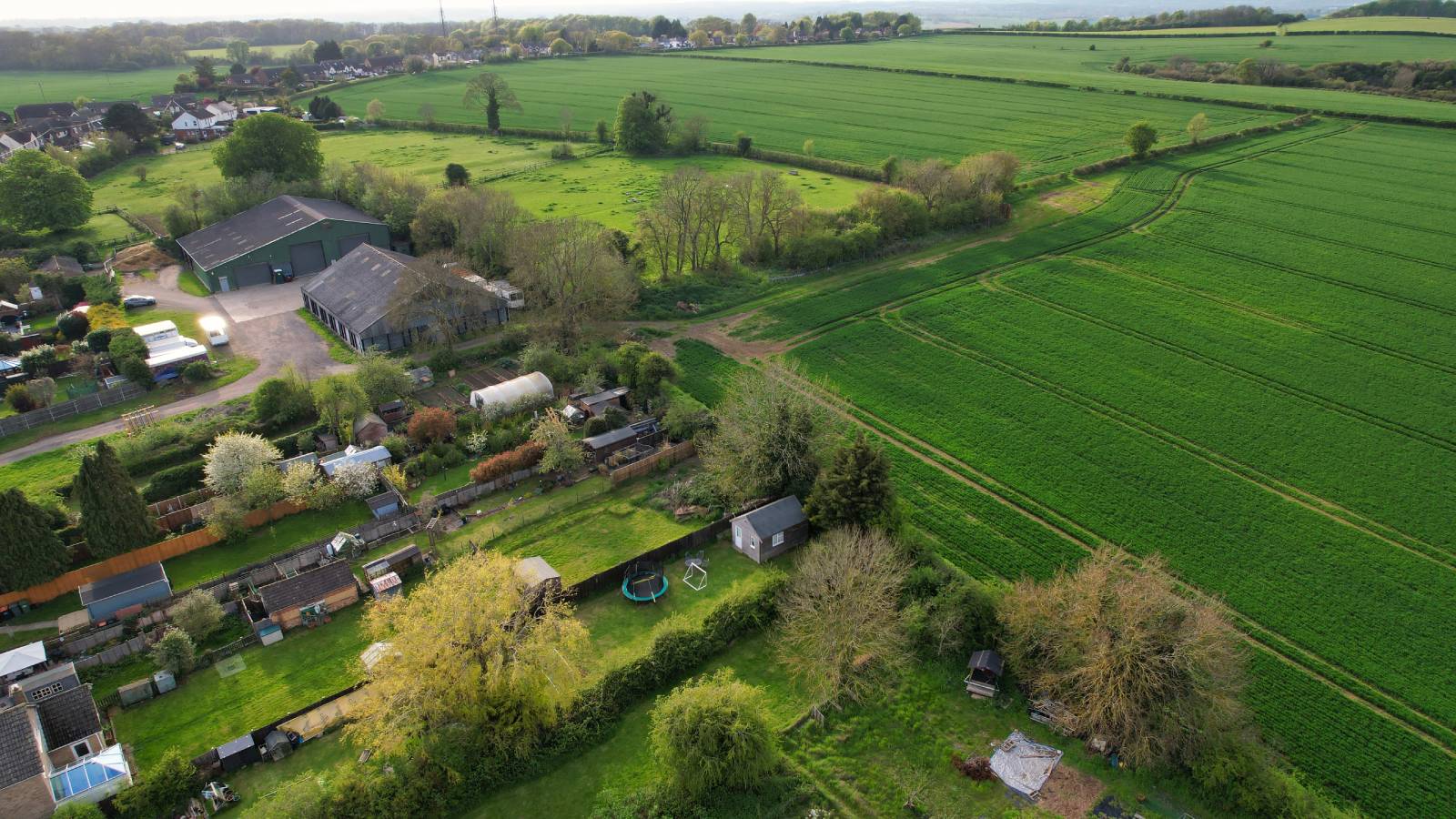8 steps to buying a building plot without planning permission — and to avoid purchasing an expensive dud
Could buying land without planning be a route to an affordable plot? Plotfinding expert Mark Stevenson shares his advice — and explains how to avoid paying a premium for land that can’t be developed

Buying land isn’t the same as buying a house, where you can easily value what you’re getting and instruct solicitors to get the deal done. When it comes to buying building land, the risks are greater and you must be certain planning permission will be granted for what you want to build.
That said, there is an even riskier approach that some take to finding a potential plot — buying a plot without planning permission in the hope that they will be able to obtain planning to build a home.
Perhaps you've spotted a large side garden ripe for development, or a parcel of land that falls within a local settlement boundary. Before approaching the landowner or agent with a view to purchasing, it's best to do your homework.
Here, I set out eight steps to follow when buying a building plot without planning permission. Perhaps the most important is securing an option to purchase, as I explain in more detail below. Adhering to these steps should help ensure you don’t get landed with an expensive dud or a parade of unwelcome surprises.
1. Establish the build budget — and what you can afford to pay for a plot
Before purchasing any type of building plot, particularly buying land without planning permission, the first step is to establish your build budget.
The purpose of buying a plot is to build a home. Therefore you’ve got to have enough money left over after buying a plot to see the project through to completion. Be honest with yourself about your budget and how far it will stretch, or you risk overcommitting by paying too much for the plot and not leaving enough to complete the build.
To make sure your budget is reliable, it’s a good idea to have your plan reviewed by a specialist self build mortgage broker first.
Bring your dream home to life with expert advice, how to guides and design inspiration. Sign up for our newsletter and get two free tickets to a Homebuilding & Renovating Show near you.
2. Appraise the plot – and sense check the potential
Before going any further, it's worth sitting back and thinking about whether the potential plot you’ve found really is right for you. Will it support what you want to build? Can you afford to take on the whole project? Are you paying the right price for the land? Are there potential challenges that could have potential to increase the build cost and blow your budget – challenging terrain, for instance?
Try to take an objective view. If you find something that can’t be overcome, now’s the time to back out.
It's also worth noting that most self builders have never built before and will therefore need a range of professionals to help them with their project.
The amount of help you’ll need will also depend on how complicated the development is. Complex architectural designs will require construction experts, and challenging plots will need engineers and surveyors to overcome the problems they’ll have. Some plots such as brownfield sites could be contaminated and require expensive remedial work.
The more the professionals you need, the bigger the bill is going to be! You must therefore work out who’ll you need on your team as early as possible and make sure your budget reflects the cost involved.
3. Hire a planning consultant
A plot’s not a plot unless you can get permission to build. You therefore need to be sure that planning isn’t an issue before going any further.
Plots without planning consent are risky and must be professionally appraised by a planning consultant to make sure approval can be secured. Depending upon how sensitive a plot is from a planning point of view, it may be worth having a pre-application meeting with the local planning authority (LPA) to see what their thoughts are.
It’s a good idea to prepare for this by pulling together a few plans and working out what your proposal might look like. The idea here is simply to go armed and provoke an opinion from the planning officer.
Don’t get ahead of yourself. You’re dealing in possibilities rather than firm plans. At this stage there’s no certainty you’ll get planning permission, so it’s best to keep expenses to a minimum. My advice is to try and source a suitable existing design rather than commissioning something bespoke. The design doesn’t have to be perfect, just enough to offer a flavour and provoke an opinion.
It’s worth noting that the opinion from the planning officer isn’t binding, so while pre-application advice might give you a good steer, it’s not reliable enough to justify purchasing the plot at this stage.
4. Calculate the plot value
Once you’ve confirmed a plot is developable and what is likely to be approved by the planning department, you can work out how much a plot is worth.
In simple terms, plot valuations are calculated by establishing the end value of the finished property and then subtracting the cost of development, including planning fees, build and design costs, and the price paid for the plot in the first instance.
5. Negotiate and secure an 'option' to purchase

Find your perfect building plot with Plotfinder.net — the UK's largest plot and renovation-finding platform, with over 15,000 opportunities available.
Once you’ve established a plot value that both parties are happy with and made certain the opportunity is right for you, the next step is to secure your right to buy it by putting an option to purchase in place.
An ‘option’ in this sense is a legal agreement between you and the landowner that gives you the exclusive right to buy the plot at an agreed price within a defined period of time.
To be legally binding an option should have a monetary value, and needs to be drawn up by solicitors to make sure that all requirements are in place.
The benefit of having an option is that it protects your investment by, for example, stopping the landowner selling the land in question to a third party once you’ve increased its value by obtaining planning consent.
Options are useful because they provide lots of wriggle room; if you can’t get planning permission or simply change your mind, you’re not obliged to continue with the purchase.
While the solicitors are putting the option agreement in place, it’s a good idea to have them check for any legal impediments that could affect the sale. For example, you need to be certain that you’ll have unobstructed right of access, no other potential access issues which could prevent development, and that there aren’t any restrictive covenants.
6. Prepare your planning application
While your planning application will be prepared by a team of professionals, there’s no time for you to sit back and relax. To do their job, that team will need a design brief. Involve yourself in the design process to make sure a proposal is produced that meets your requirements.
A key concern is to keep your budget at the forefront of the process so that you end up with a proposed design you can afford to build.
The planning application will need to be supported by a host of surveys and reports depending upon the plot’s sensitives and constraints. Your planning consultant will be able to recommend the professionals needed to do this. Take their advice to give your project the best chance of success.
With an option is in place, you’re safe to spend whatever fees are necessary to develop a detailed design and secure planning consent.
But a word of caution: Remember that if the application fails you’ll still have to pay the fees, so make sure they’re affordable.
7. Obtain planning permission
Once you’ve signed off the design, your planning application can be prepared and submitted to your local planning authority (LPA).
Strictly speaking, approval should be issued within eight weeks as long as the application is straightforward. This time only starts ticking from when the LPA accepts receipt of the application, so keep an eye out for that. Theory notwithstanding, you should consider three months a good turnaround.
More often than not, the planning departments are under-resourced and as a result the process can be a little bumpy. Planning officers may well request extensions of time to give themselves longer to consider the application.
Securing planning consent usually involves some careful negotiations. Amendments to your proposal may well be required to show that you have taken on board the planning officers’ comments. My advice is to be receptive. Don’t dig your heels in as you’ll be running the risk of provoking a refusal.
Hopefully, by the end of the process, approval will be granted and you’ll be able to breathe a satisfied sigh. However, if it’s refused don’t panic. Read the refusal notice and learn why the application was turned down. Look for grounds to appeal the planning decision, and if you have them, appeal to the secretary of state within six months of the refusal notice.
8. Purchase the plot
The time from identifying a plot through to securing planning permission and buying it can be anything from nine to 18 months.
Obviously, you can accelerate things by cutting corners, but I’d advise against doing so as it will significantly increase your risks. My advice is to take things one stage at a time so you don’t end up paying a premium for a piece of land that has no chance of being developed. You’ve been warned!
If and when permission is granted, give yourself a moment to celebrate. You can now commence the purchase of the plot!
Sadly there is no time to rest. The moment you become the owner, you’ll be liable for anything that happens on the plot. You should therefore prepare for the first day of ownership by making arrangements for self build insurance and securing the site boundaries.

Plotfinder.net is Homebuilding & Renovating's sister site that has thousands of self build and renovation opportunities from estate agents, auction sites and private owners across the UK. Subscribe today and get email alerts for potential plots straight to your inbox.
Mark Stevenson has worked as a construction professional for over 30 years and following an extensive career in housebuilding. He is currently chief operating officer for Custom Build Homes and chair of the National Custom and Self Build Association. He previously worked as managing director for Potton, helping self builders build their own homes.
Whilst Mark describes himself as a ‘professional builder’ as a result of his career in housebuilding and timber building system manufacturing, he has specialist knowledge of timber construction and extensive expertise in finding land and project management.
He regularly shares his knowledge at Homebuilding & Renovating Shows and and coaches self builders about how to build their own homes. Aside from Mark’s professional career, his skills also extend to practical building knowledge as a skilled joiner, hands-on renovator and serial self-builder of his own development projects.
He is also Vice Chair of industry body, the Structural Timber Association.

